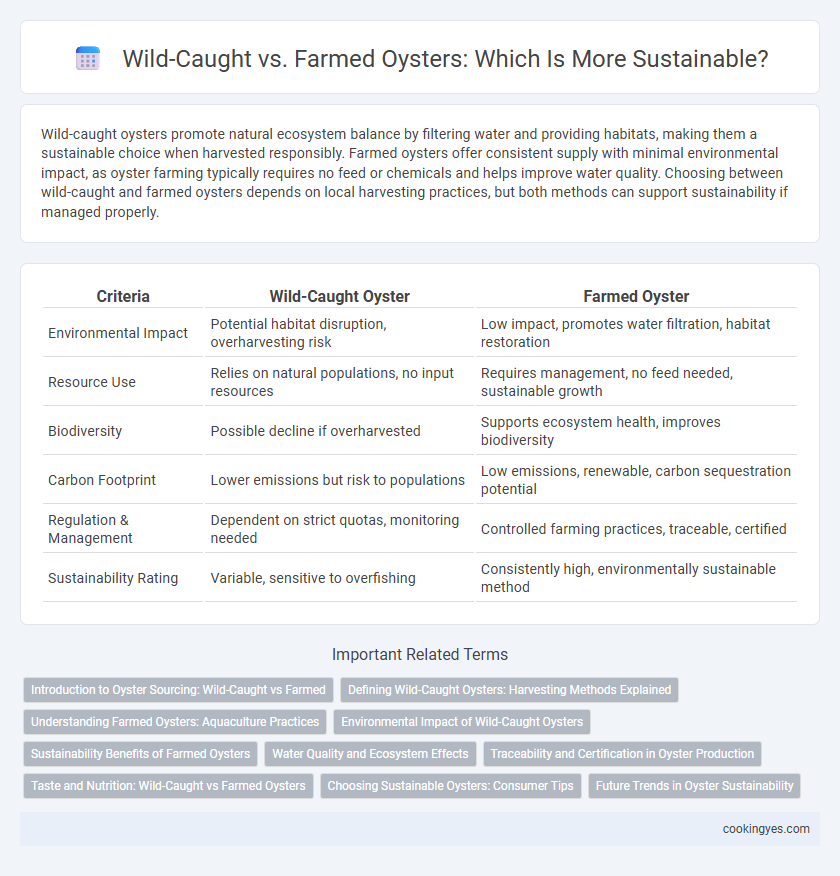Wild-caught oysters promote natural ecosystem balance by filtering water and providing habitats, making them a sustainable choice when harvested responsibly. Farmed oysters offer consistent supply with minimal environmental impact, as oyster farming typically requires no feed or chemicals and helps improve water quality. Choosing between wild-caught and farmed oysters depends on local harvesting practices, but both methods can support sustainability if managed properly.
Table of Comparison
| Criteria | Wild-Caught Oyster | Farmed Oyster |
|---|---|---|
| Environmental Impact | Potential habitat disruption, overharvesting risk | Low impact, promotes water filtration, habitat restoration |
| Resource Use | Relies on natural populations, no input resources | Requires management, no feed needed, sustainable growth |
| Biodiversity | Possible decline if overharvested | Supports ecosystem health, improves biodiversity |
| Carbon Footprint | Lower emissions but risk to populations | Low emissions, renewable, carbon sequestration potential |
| Regulation & Management | Dependent on strict quotas, monitoring needed | Controlled farming practices, traceable, certified |
| Sustainability Rating | Variable, sensitive to overfishing | Consistently high, environmentally sustainable method |
Introduction to Oyster Sourcing: Wild-Caught vs Farmed
Wild-caught oysters are harvested directly from natural habitats, preserving local ecosystems through their natural filtration of water and promoting biodiversity. Farmed oysters are cultivated in controlled environments, reducing pressure on wild populations and enabling sustainable production with minimized environmental impact. Choosing between wild-caught and farmed oysters involves weighing ecological benefits, harvest methods, and long-term sustainability of oyster populations.
Defining Wild-Caught Oysters: Harvesting Methods Explained
Wild-caught oysters are harvested directly from natural coastal habitats, using methods like hand-picking, dredging, and tonging that minimally disrupt the ecosystem. These techniques allow oysters to grow in their native environment, supporting biodiversity and maintaining water quality through natural filtration. Sustainable wild-catch practices ensure the preservation of oyster populations and their critical role in coastal ecosystems.
Understanding Farmed Oysters: Aquaculture Practices
Farmed oysters are cultivated through aquaculture practices that mimic natural habitats while promoting ecological balance by filtering water and enhancing biodiversity. These sustainable farming methods reduce pressure on wild oyster populations, helping preserve marine ecosystems affected by overharvesting and habitat loss. Advanced techniques like bottom culture, off-bottom culture, and recirculating systems optimize growth rates and minimize environmental impact.
Environmental Impact of Wild-Caught Oysters
Wild-caught oysters contribute to ecosystem balance by naturally filtering water, enhancing marine biodiversity, and supporting habitat complexity without introducing external substances. Their harvesting, when managed sustainably, minimizes habitat disruption and maintains natural population dynamics essential for coastal resilience. Overharvesting risks depletion, but regulated wild catch practices help preserve oyster reefs and associated environmental benefits.
Sustainability Benefits of Farmed Oysters
Farmed oysters contribute significantly to sustainability by improving water quality through their natural filtration process, filtering up to 50 gallons of water per oyster per day. Unlike wild-caught oysters, farming prevents habitat destruction and helps maintain coastal ecosystems by reducing overharvesting pressures. Moreover, oyster farms support biodiversity enhancement and provide renewable, low-impact protein sources essential for sustainable seafood production.
Water Quality and Ecosystem Effects
Wild-caught oysters contribute to water quality by naturally filtering pollutants and improving marine ecosystems, but overharvesting can disrupt habitats and reduce biodiversity. Farmed oysters offer a controlled environment that minimizes habitat destruction and can enhance water clarity through filtration, yet improper farming practices may lead to nutrient pollution and localized ecosystem imbalances. Sustainable oyster harvesting balances wild population conservation with responsible aquaculture techniques to protect water quality and maintain healthy marine ecosystems.
Traceability and Certification in Oyster Production
Wild-caught oysters offer high traceability through direct harvesting locations, while farmed oysters benefit from certification programs such as the Aquaculture Stewardship Council (ASC) and Best Aquaculture Practices (BAP) that ensure sustainable production standards. Traceability systems in oyster farming enhance transparency by tracking the entire production chain from seed to sale, reducing environmental risks and promoting responsible resource management. Certification frameworks validate sustainability claims, enabling consumers to make informed decisions and support ecosystem-friendly oyster cultivation.
Taste and Nutrition: Wild-Caught vs Farmed Oysters
Wild-caught oysters generally offer a more complex, brinier flavor due to their varied natural diet, while farmed oysters have a milder taste influenced by controlled growing conditions. Nutritionally, both wild-caught and farmed oysters provide essential vitamins like B12 and minerals such as zinc and iron, but farmed oysters often contain higher omega-3 fatty acids due to optimized feeding practices. The sustainability of farmed oysters is typically superior, as their cultivation can support ecosystem health through water filtration without depleting wild populations.
Choosing Sustainable Oysters: Consumer Tips
Wild-caught oysters are often considered more sustainable due to their natural habitat and minimal environmental impact, while farmed oysters contribute to water filtration and habitat restoration but vary in sustainability based on farming practices. Consumers should prioritize oysters certified by organizations like the Marine Stewardship Council (MSC) or Aquaculture Stewardship Council (ASC) to ensure responsible sourcing. Choosing oysters from transparent sources that use eco-friendly harvesting or farming methods supports ocean health and promotes sustainable seafood consumption.
Future Trends in Oyster Sustainability
Wild-caught oysters support natural ecosystems by filtering water and providing habitat, yet overharvesting threatens their populations, prompting a shift toward sustainable aquaculture practices. Farmed oysters offer controlled growth environments that reduce pressure on wild stocks and enhance water quality through biofiltration. Future trends in oyster sustainability emphasize innovative farming techniques, such as integrated multi-trophic aquaculture and genetic selection for disease-resistant strains, aiming to balance environmental impact with economic viability.
Wild-caught vs Farmed Oyster for sustainability Infographic

 cookingyes.com
cookingyes.com